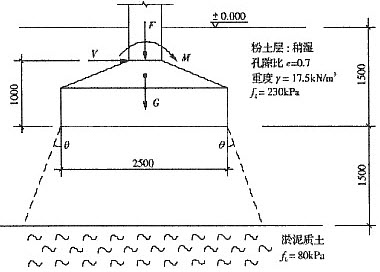问题
单项选择题
某柱下钢筋混凝土独立基础,基础底面尺寸为2.0m×2.5m。持力层为粉土,其下为淤泥质土软弱层。由柱底传竖向力为F,力矩为M和水平剪力为V(均为设计值),如题图所示。计算基础自重设计值和基础上的土重标准值用的平均重度γG=20kN/m3。

当粉土层的压缩模量Es1=8MPa、淤泥质土层的压缩模量Es2=2MPa时,其地基压力扩散线与垂直线的夹角θ应取()项数值。
A.θ=22°
B.θ=24°
C.θ=30°
D.θ=40°
答案
参考答案:B
解析:

由规范表5.2.7查得0=24°

